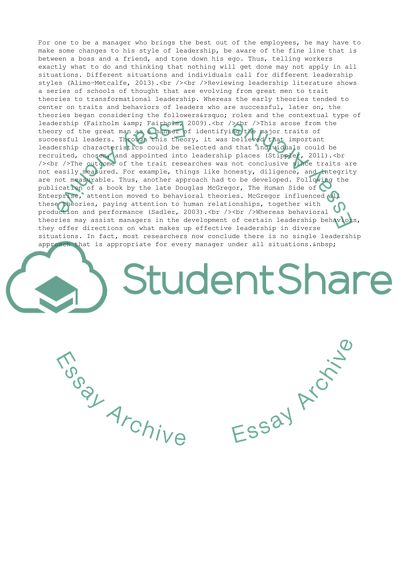Cite this document
(A Critical Review of Leadership Theory Coursework Example | Topics and Well Written Essays - 1500 words, n.d.)
A Critical Review of Leadership Theory Coursework Example | Topics and Well Written Essays - 1500 words. https://studentshare.org/management/1811541-i-have-to-tell-my-workers-exactly-what-to-do-otherwise-nothing-will-get-done-to-what-extent-do-you-agree-with-this-approach-to-leadership-support-your-points-with-references-and-examples
A Critical Review of Leadership Theory Coursework Example | Topics and Well Written Essays - 1500 words. https://studentshare.org/management/1811541-i-have-to-tell-my-workers-exactly-what-to-do-otherwise-nothing-will-get-done-to-what-extent-do-you-agree-with-this-approach-to-leadership-support-your-points-with-references-and-examples
(A Critical Review of Leadership Theory Coursework Example | Topics and Well Written Essays - 1500 Words)
A Critical Review of Leadership Theory Coursework Example | Topics and Well Written Essays - 1500 Words. https://studentshare.org/management/1811541-i-have-to-tell-my-workers-exactly-what-to-do-otherwise-nothing-will-get-done-to-what-extent-do-you-agree-with-this-approach-to-leadership-support-your-points-with-references-and-examples.
A Critical Review of Leadership Theory Coursework Example | Topics and Well Written Essays - 1500 Words. https://studentshare.org/management/1811541-i-have-to-tell-my-workers-exactly-what-to-do-otherwise-nothing-will-get-done-to-what-extent-do-you-agree-with-this-approach-to-leadership-support-your-points-with-references-and-examples.
“A Critical Review of Leadership Theory Coursework Example | Topics and Well Written Essays - 1500 Words”. https://studentshare.org/management/1811541-i-have-to-tell-my-workers-exactly-what-to-do-otherwise-nothing-will-get-done-to-what-extent-do-you-agree-with-this-approach-to-leadership-support-your-points-with-references-and-examples.


